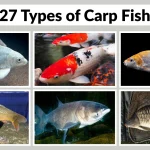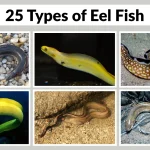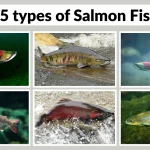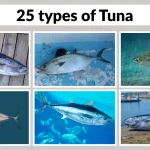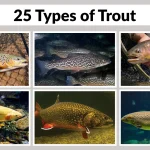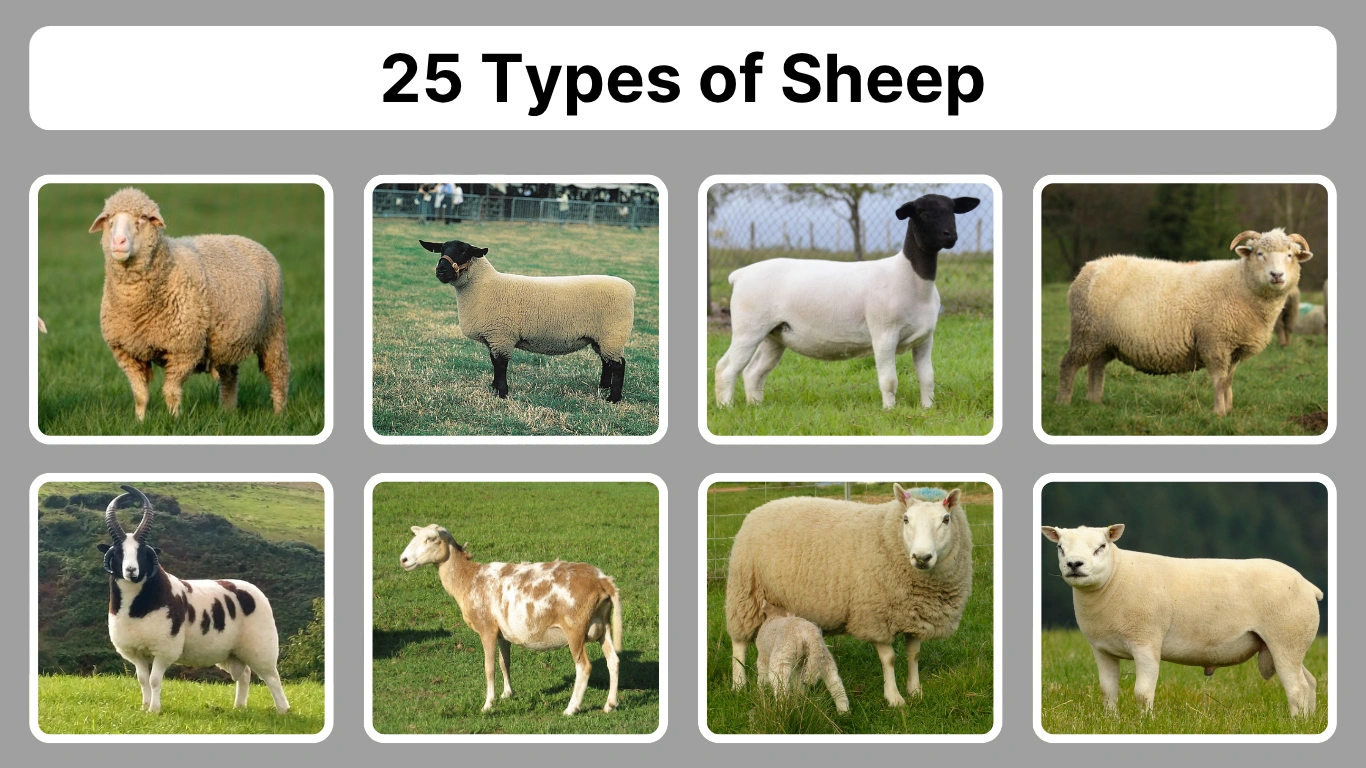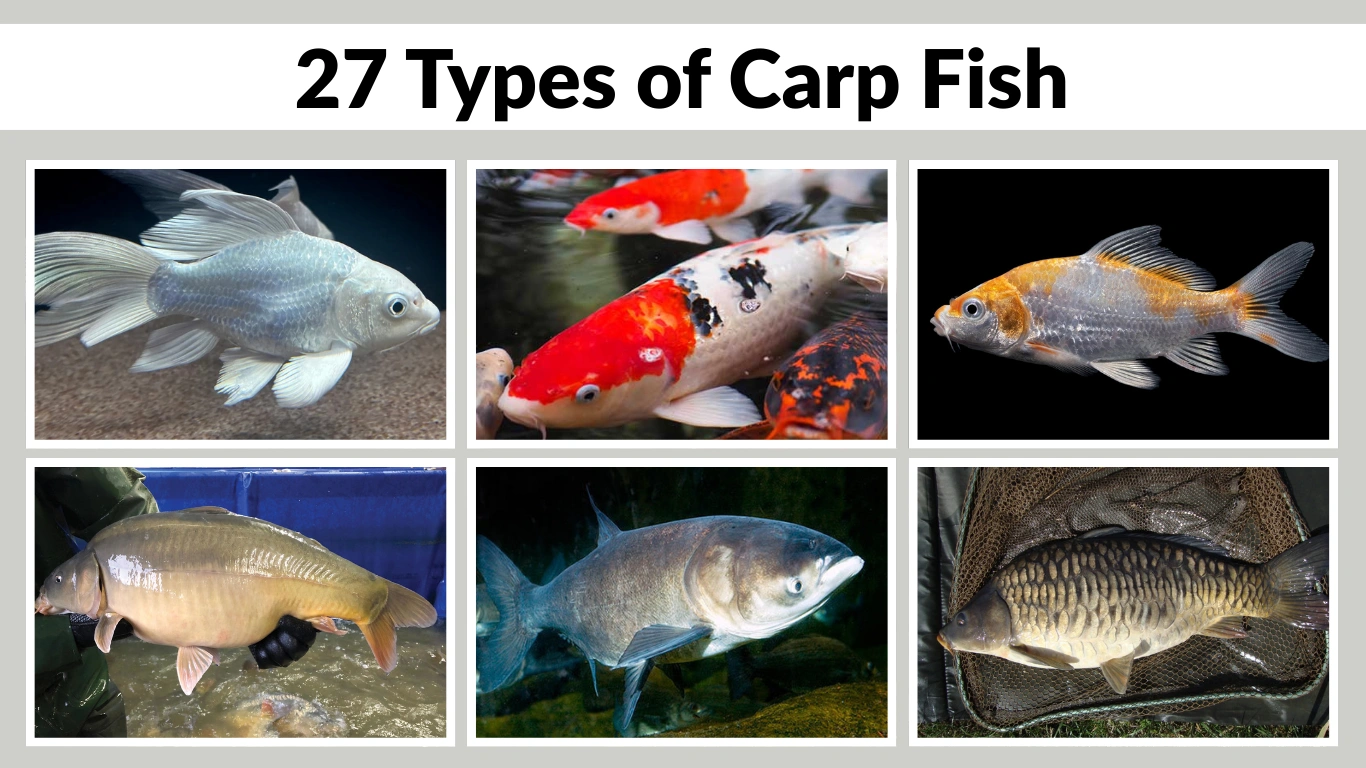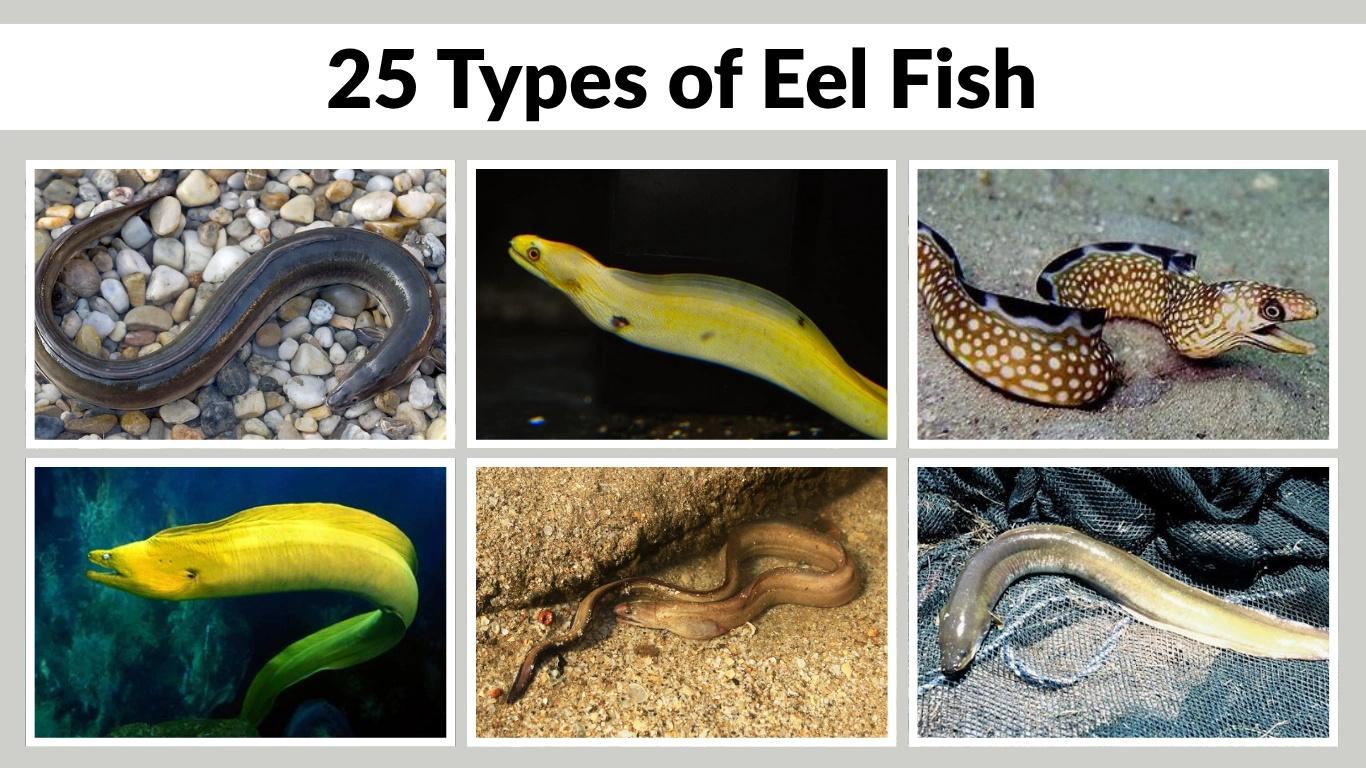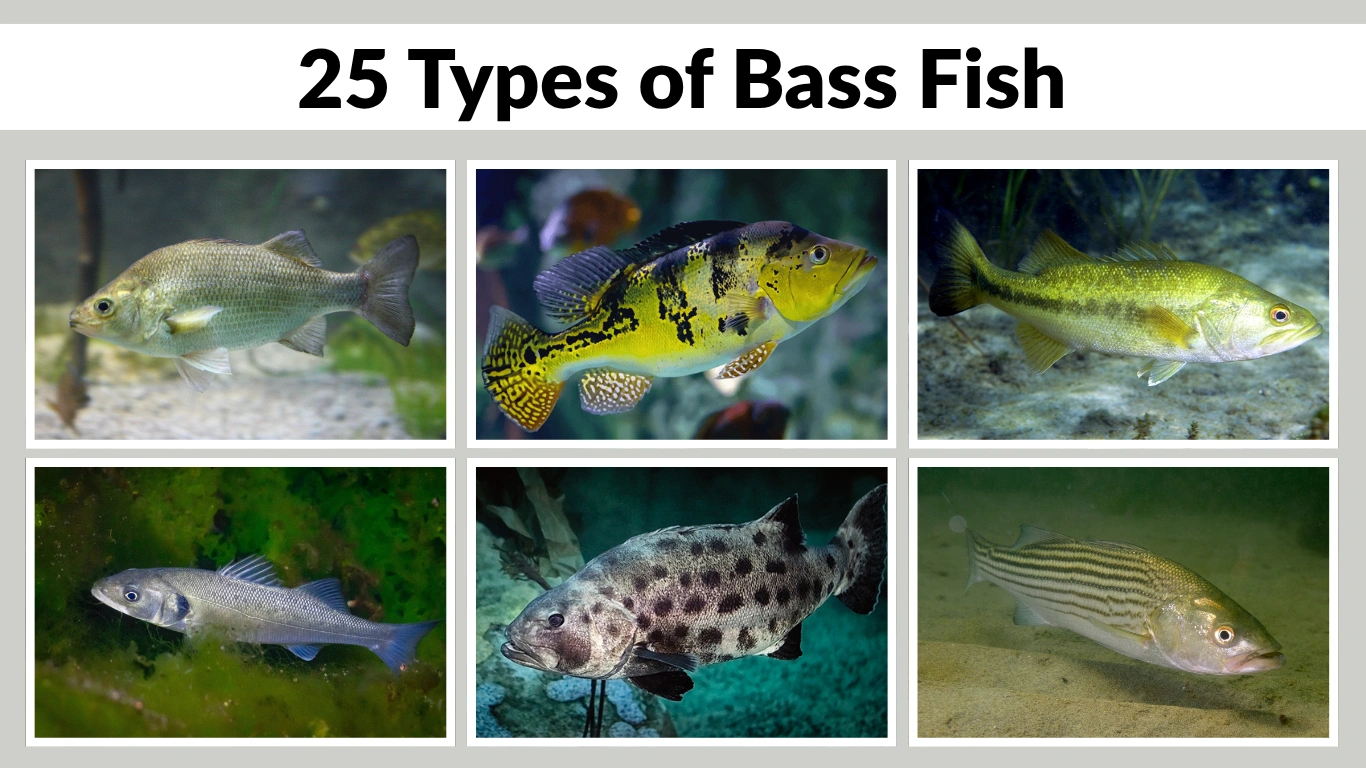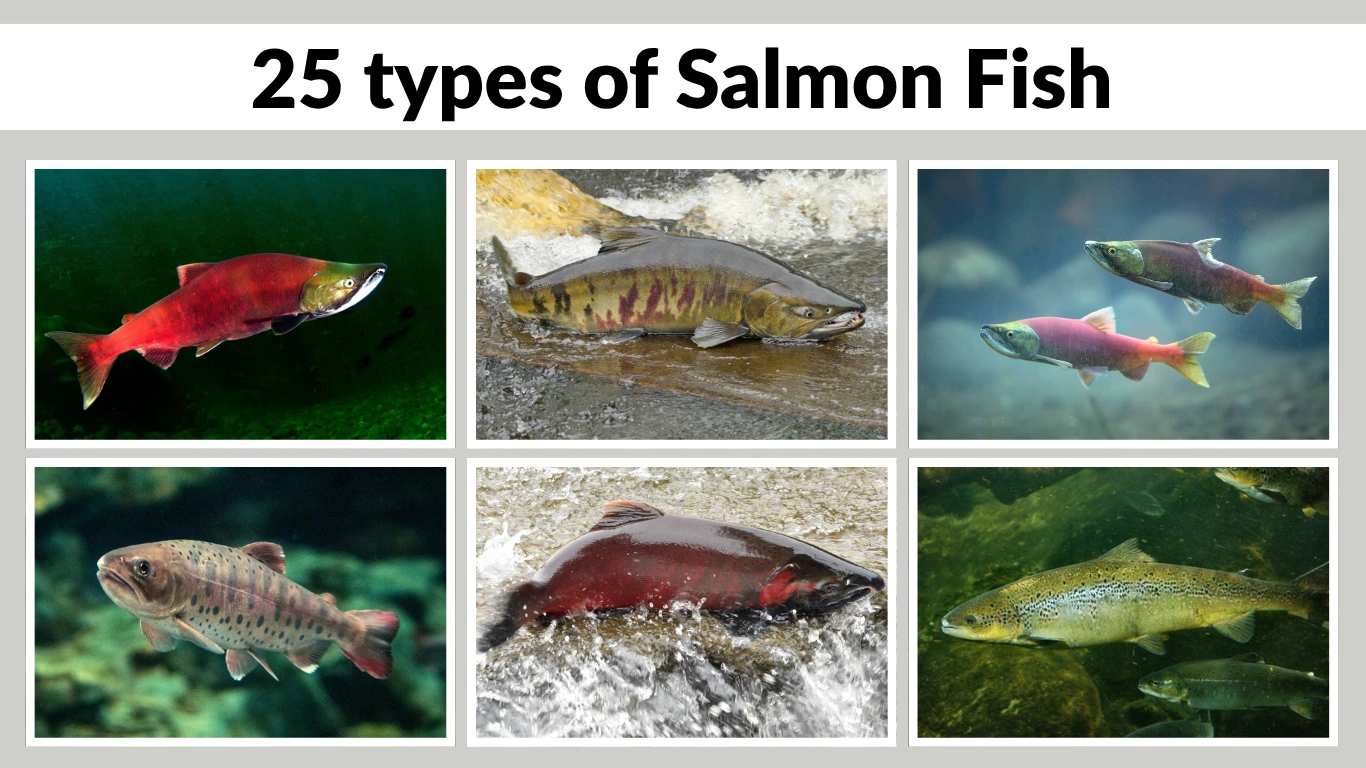Sheep are among the most diverse and valuable livestock animals, raised worldwide for their wool, meat, milk, and even hides. With hundreds of distinct breeds adapted to various climates and farming systems, each type of sheep brings something unique to the table—whether it’s the ultra-fine fleece of the Merino, the hardy nature of the Scottish Blackface, or the parasite resistance of the Katahdin.
In this comprehensive guide, you’ll explore 25 different sheep breeds from around the world. Each section highlights the breed’s physical traits, natural habitat, wool or meat value, and behavior—offering insights for farmers, hobbyists, and fiber artists alike. Whether you’re starting a flock or expanding your knowledge, this guide reveals how diverse and fascinating the world of sheep truly is.
1. Merino Sheep

Merino Sheep are one of the most renowned and valuable sheep breeds in the world, primarily raised for their exceptionally fine and soft wool. Originating from Spain and later refined in Australia and New Zealand, Merinos are a cornerstone of the global wool industry.
Identification
- Size: Medium-sized breed
- Color: White face and body
- Wool: Extremely fine, dense, and crimped; grows continuously
- Face: Wool-covered with a narrow muzzle
- Horns: Rams may be horned with long spirals; ewes are usually polled (hornless)
- Weight: Rams: 180–235 pounds, Ewes: 120–180 pounds
Natural Habitat and Distribution
Merino Sheep thrive in dry, temperate climates and are commonly found in Australia, New Zealand, South Africa, and parts of South America and the U.S. They are typically raised in open rangelands, where their strong legs and hardy nature allow them to cover large areas in search of food.
Wool Production and Quality
Merino wool is prized for its softness, breathability, and ability to regulate temperature. It is hypoallergenic and ideal for high-performance and luxury garments. The fleece is typically sheared once a year, producing 10–20 pounds of wool per sheep depending on the variety.
Behavior and Characteristics
Merinos are intelligent, calm, and adaptable. They are not typically raised for meat, as their wool is far more economically valuable. They do best in well-managed flocks and are often part of selective breeding programs to improve fleece yield and quality. Regular shearing is essential, as their wool does not stop growing.
2. Suffolk Sheep

Suffolk Sheep are a large, fast-growing breed known for their excellent meat production and distinctive appearance. Originating in England in the 18th century, they are now widely raised around the world for commercial lamb and mutton production.
Identification
- Size: Large and muscular
- Color: White body with a black face and legs (wool-free)
- Wool: Medium fleece, primarily used for blankets and socks
- Face: Clean and black with long ears and no wool
- Horns: Polled (naturally hornless)
- Weight: Rams: 250–350 pounds, Ewes: 180–250 pounds
Natural Habitat and Distribution
Suffolk Sheep are adaptable and thrive in a wide range of climates, from cool temperate zones to warm regions. They are commonly found in the UK, USA, Australia, and New Zealand, primarily raised on pastures and grasslands.
Meat Production and Qualities
Suffolks are primarily bred for meat. They produce lean, flavorful cuts and are well-known for their rapid growth rates and feed efficiency. Lambs mature quickly, making them a top choice in commercial sheep farming.
Behavior and Characteristics
Suffolk Sheep are docile, hardy, and easy to manage. They lamb easily and make excellent terminal sires for crossbreeding. Their calm temperament and solid build also make them popular in youth agricultural programs like 4-H and FFA.
3. Dorper Sheep
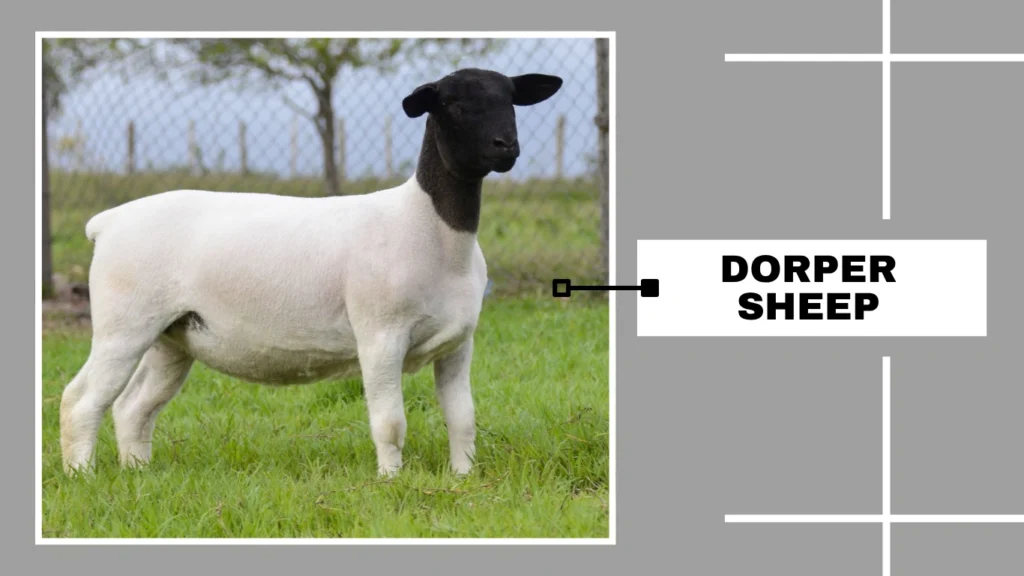
The Dorper is a hardy, fast-growing meat sheep breed developed in South Africa by crossing Dorset Horn and Blackhead Persian sheep. It is one of the most popular hair sheep breeds, especially suited for arid and semi-arid environments.
Identification
- Size: Medium to large
- Color: Most commonly white body with a black head (Blackhead Dorper); all-white versions also exist (White Dorper)
- Wool: Hair and wool mix that sheds naturally
- Face: Black or white, short muzzle
- Horns: Polled
- Weight: Rams: 230–270 pounds, Ewes: 170–200 pounds
Natural Habitat and Distribution
Dorpers are extremely adaptable and thrive in hot, dry climates where other breeds may struggle. They are widely raised in South Africa, Australia, the United States, and the Middle East, particularly in low-maintenance grazing systems.
Meat Production and Qualities
Dorper Sheep are known for producing high-quality, mild-flavored meat with excellent fat distribution. Their carcass yield is impressive, and they grow quickly even on poor forage.
Behavior and Characteristics
Dorpers are calm, fertile, and low-maintenance. They don’t require shearing due to their natural shedding coat, making them ideal for farmers who want reduced labor and wool processing. Their strong mothering instincts and year-round breeding ability also contribute to their popularity.
4. Dorset Sheep
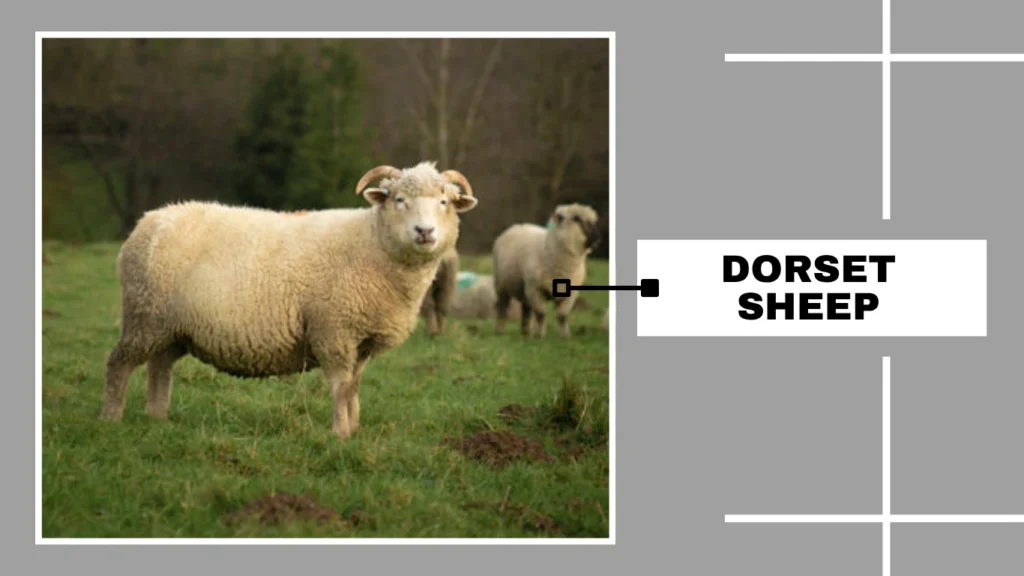
Dorset Sheep are a versatile and productive breed known for both meat and wool. Originally from England, the Dorset is valued for its ability to breed out of season, making it one of the few sheep breeds capable of producing lambs year-round.
Identification
- Size: Medium to large
- Color: Completely white body, face, and legs
- Wool: Dense, medium-grade fleece covering body and parts of face and legs
- Face: Broad, white, and woolly with alert expression
- Horns: Found in both horned and polled (hornless) varieties
- Weight: Rams: 225–275 pounds, Ewes: 150–200 pounds
Natural Habitat and Distribution
Dorset Sheep adapt well to various climates and terrains. They are raised extensively in the UK, United States, Australia, and other parts of the world, especially in regions with good grazing pastures and controlled lambing systems.
Meat Production and Qualities
They are prized for their muscular build, early maturity, and excellent carcass quality. Dorset lamb is tender and mild, with a good fat-to-meat ratio. They are a popular terminal sire in commercial flocks.
Behavior and Characteristics
Dorsets are docile, intelligent, and excellent mothers. Their ability to breed out of season allows for flexible lambing schedules, making them valuable for producers aiming for year-round meat supply. They are also easy to handle and manage in both pasture and confinement systems.
5. Rambouillet Sheep
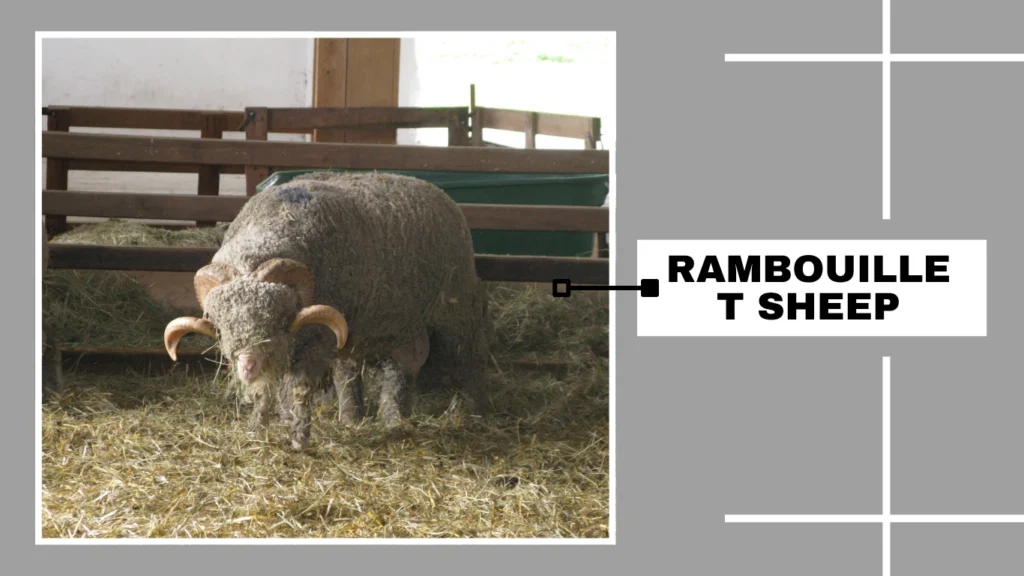
The Rambouillet is a historic and influential French breed known for its exceptional wool and hardiness. It played a key role in developing the American wool industry and remains a top choice for fine fleece and dual-purpose farming.
Identification
- Size: Large and robust
- Color: White fleece with a clean face and legs
- Wool: Fine, dense, and high-yielding fleece; often covers parts of the face and legs
- Face: Narrow with a slightly curved nose
- Horns: Rams often horned with long spirals; ewes usually polled
- Weight: Rams: 250–350 pounds, Ewes: 150–200 pounds
Natural Habitat and Distribution
Rambouillet Sheep thrive in arid and semi-arid regions, especially in the western United States, Australia, and Europe. Their strong legs and stamina make them ideal for open-range grazing in rugged terrain.
Wool Production and Qualities
Their fleece is one of the finest among dual-purpose breeds, used in high-quality garments and textiles. A single sheep can yield 8–18 pounds of wool per year. The fibers are dense, elastic, and highly crimped.
Behavior and Characteristics
Rambouillets are calm, resilient, and excellent foragers. They are hardy enough to withstand harsh climates and long-distance grazing. Their strong maternal traits and long productive lifespan make them a mainstay in both wool and meat operations.
6. Hampshire Sheep
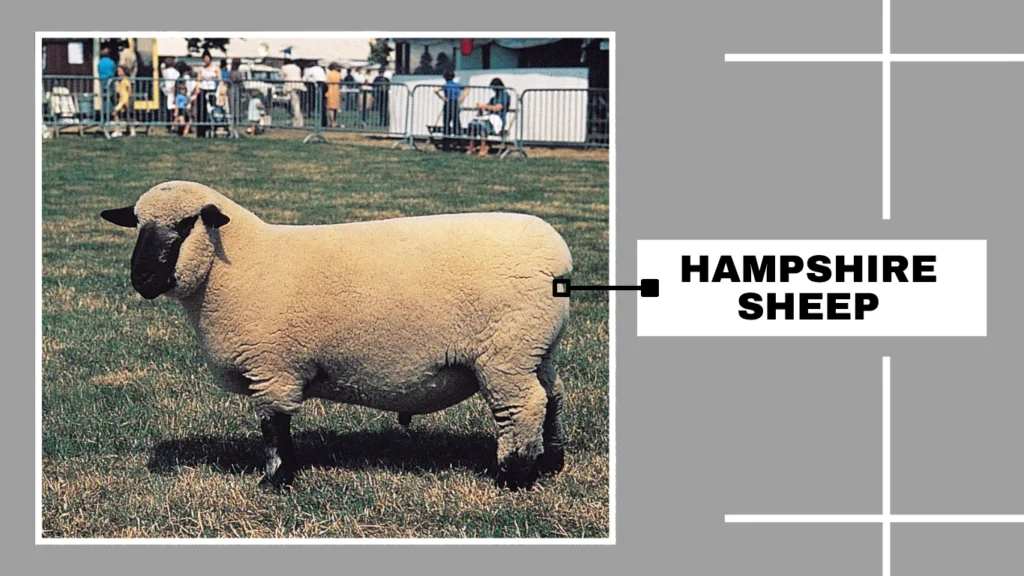
Hampshire Sheep are a popular meat breed known for their rapid growth, strong muscling, and eye-catching appearance. Originating in southern England, they are now widely raised across the United States and other countries for high-quality lamb production.
Identification
- Size: Large and powerful frame
- Color: White body with a black face and legs; face and legs are wool-free
- Wool: Medium fleece, limited to the body; face and legs remain bare
- Face: Broad with a Roman nose
- Horns: Polled (hornless)
- Weight: Rams: 275–325 pounds, Ewes: 200–250 pounds
Natural Habitat and Distribution
Hampshire Sheep thrive in temperate climates and are well-suited for pasture-based or grain-fed systems. They are raised widely in the U.S., UK, and parts of Australia, favored in both purebred and commercial flocks.
Meat Production and Qualities
They are excellent terminal sires, producing fast-growing lambs with high-yield carcasses. Hampshire lambs are noted for their superior feed efficiency and well-marbled meat, making them ideal for market.
Behavior and Characteristics
Hampshires are active, alert, and have strong maternal instincts. They lamb easily and are often used in crossbreeding to improve meat traits. Their calm nature and large size make them manageable in flocks and popular in youth livestock projects.
7. Jacob Sheep
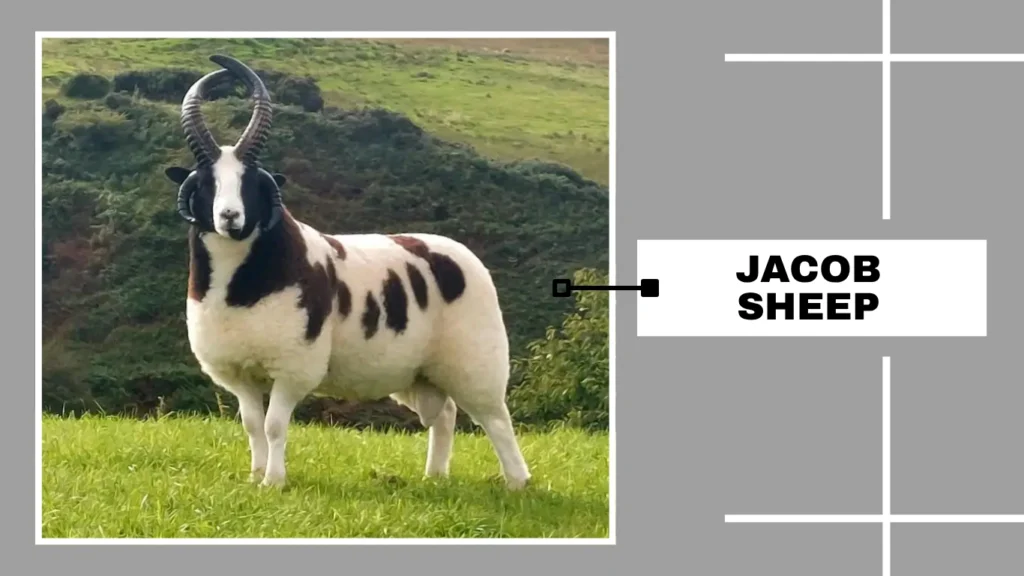
Jacob Sheep are a unique and ancient breed known for their multi-horned appearance and piebald (spotted) coloration. They are often raised for their novelty, attractive wool, and hardiness, making them a favorite among small-scale farmers and hobbyists.
Identification
- Size: Small to medium
- Color: White fleece with distinct black or brown patches
- Wool: Lightweight fleece with open texture; suitable for handspinning
- Face: Narrow with fine features
- Horns: 2, 4, or even 6 horns—both rams and ewes may be horned
- Weight: Rams: 120–180 pounds, Ewes: 80–120 pounds
Natural Habitat and Distribution
Jacob Sheep are adaptable and do well in various climates. They originated in the British Isles and are now raised in North America and Europe, particularly in farms that value heritage or rare breeds.
Wool Production and Qualities
Their fleece is soft, springy, and often sought after by hand spinners. The natural coloration allows for creative textile use without the need for dyes.
Behavior and Characteristics
Jacob Sheep are hardy, independent, and excellent foragers. They require minimal intervention and adapt well to low-input farming systems. Despite their wild look, they are generally docile and manageable. Their distinctive appearance and versatility make them a prized breed in conservation and artisan farming.
8. Katahdin Sheep
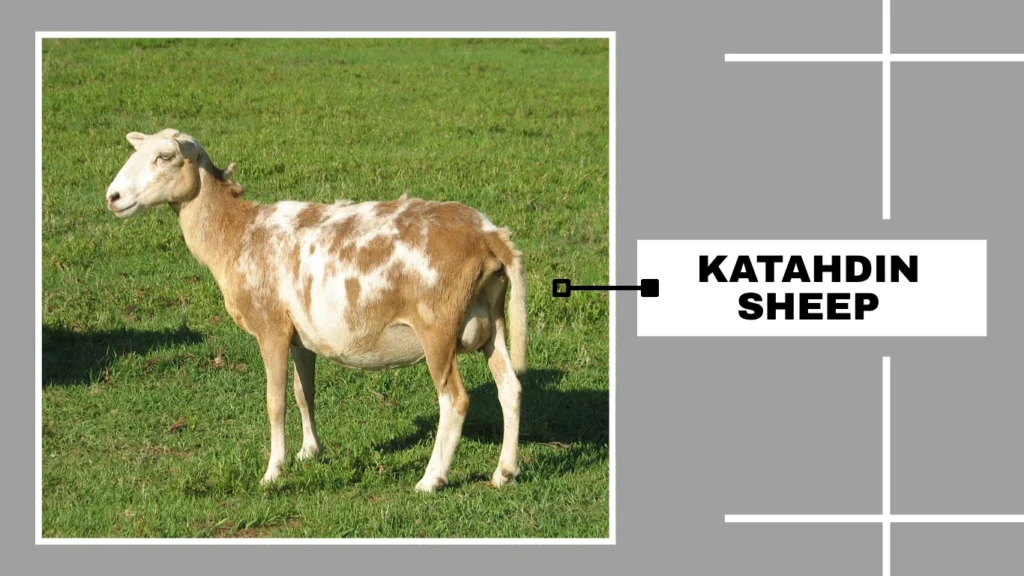
Katahdin Sheep are a hardy, low-maintenance, hair sheep breed developed in the United States. Named after Mount Katahdin in Maine, this breed is best known for its natural shedding ability, parasite resistance, and excellent meat production without the need for shearing.
Identification
- Size: Medium to large
- Color: Can be white, brown, black, or spotted
- Wool: Hair coat that sheds naturally—no shearing required
- Face: Clean with alert eyes and short ears
- Horns: Polled (naturally hornless)
- Weight: Rams: 180–250 pounds, Ewes: 120–160 pounds
Natural Habitat and Distribution
Katahdin Sheep are well-suited for diverse climates, including hot, humid regions where wool sheep may struggle. They are especially popular in the U.S., particularly in the South and Midwest, where minimal care and good pasture performance are priorities.
Meat Production and Qualities
Katahdins are bred primarily for meat. Their carcasses are lean, mild-flavored, and heavily muscled. They are efficient grazers and finish well on grass, making them ideal for grass-fed lamb operations.
Behavior and Characteristics
They are known for being calm, hardy, and excellent mothers. Katahdins are low-input animals that lamb easily and are highly resistant to internal parasites, reducing the need for chemical treatments. Their ability to thrive on pasture with minimal labor makes them perfect for small farms and sustainable systems.
9. Cheviot Sheep
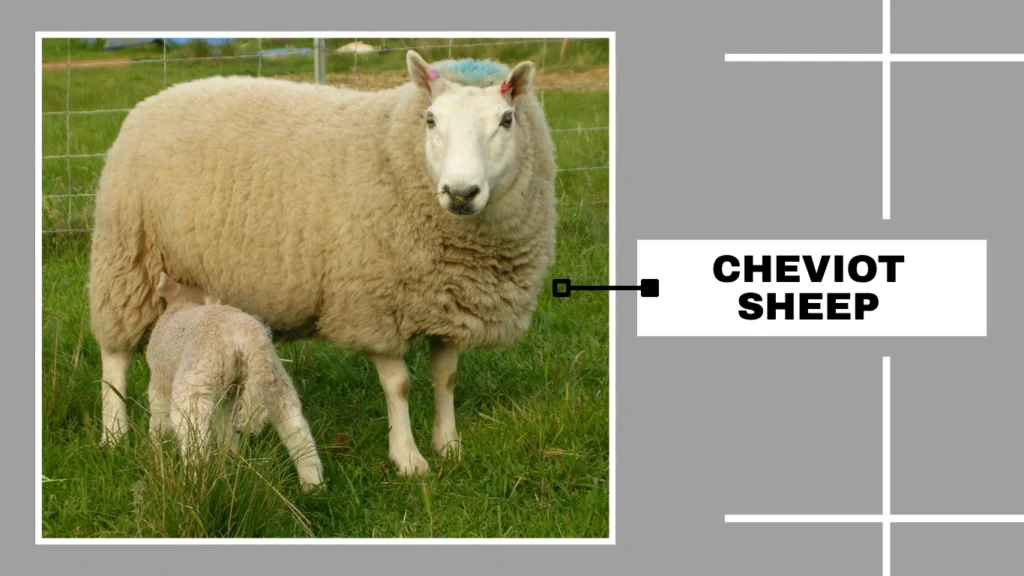
Cheviot Sheep are a hardy, alert, and stylish breed originally from the Cheviot Hills on the border of England and Scotland. They are known for their strong foraging ability, distinctive upright ears, and clean white faces.
Identification
- Size: Medium
- Color: White body with a clean, wool-free face and legs
- Wool: Dense, high-quality fleece with a crisp texture
- Face: White with prominent, erect ears
- Horns: Polled
- Weight: Rams: 160–200 pounds, Ewes: 120–160 pounds
Natural Habitat and Distribution
Cheviots are mountain and upland sheep, bred to withstand harsh weather and rough terrain. They are raised extensively in the UK, the U.S., and Canada, especially in hilly or marginal grazing lands.
Wool Production and Qualities
Their fleece is of medium length, durable, and highly valued in spinning and knitting. The wool has a well-defined crimp and bright white color, ideal for creating strong, warm fabrics.
Behavior and Characteristics
Cheviots are independent, alert, and extremely tough. They are active grazers that thrive in poor pasture conditions. Though less docile than some breeds, their survivability and low-maintenance nature make them valuable for rugged environments and crossbreeding programs.
10. Texel Sheep

Texel Sheep are a heavily muscled, meat-focused breed originating from the island of Texel in the Netherlands. They are highly valued in commercial sheep production for their superior carcass quality and high feed efficiency.
Identification
- Size: Medium to large, very muscular build
- Color: White body with a clean white face and legs
- Wool: Medium-grade, dense fleece
- Face: Short, broad face with a strong jaw and no wool on the head
- Horns: Polled
- Weight: Rams: 200–300 pounds, Ewes: 150–200 pounds
Natural Habitat and Distribution
Texels adapt well to moderate climates and are commonly found in Europe, the UK, the United States, Australia, and New Zealand. They thrive in pasture-based systems where high growth rates and meat yield are desired.
Meat Production and Qualities
Renowned for their lean, well-muscled carcasses, Texel Sheep produce meat with minimal fat and excellent tenderness. They are often used as terminal sires in crossbreeding to enhance meat quality in lambs.
Behavior and Characteristics
Texels are hardy, thrifty, and excellent foragers. They are calm and easy to handle, though rams can be assertive. Their lambs grow quickly and yield high-dressing percentages, making them one of the top meat breeds globally.
11. Southdown Sheep

Southdown Sheep are one of the oldest British sheep breeds, developed in the South Downs of England. They are small, compact, and known for producing fine-grained, flavorful lamb. Southdowns are ideal for small farms and show purposes.
Identification
- Size: Small to medium
- Color: Light gray to brown face and legs; body covered in dense white wool
- Wool: Fine, short fleece with tight crimp
- Face: Woolly with a rounded muzzle; clean below the eyes
- Horns: Polled
- Weight: Rams: 180–230 pounds, Ewes: 130–180 pounds
Natural Habitat and Distribution
They do well in temperate, lowland areas with good grazing. Southdowns are raised primarily in the UK and North America, especially by small-scale and hobby farmers due to their docile nature and manageable size.
Meat Production and Qualities
Southdown lambs are known for their excellent flavor, tenderness, and high market value. While not the fastest-growing breed, they finish early and produce well-marbled meat suitable for premium lamb markets.
Behavior and Characteristics
Southdowns are docile, friendly, and easy to manage—perfect for beginner shepherds and children’s livestock programs. They adapt well to confinement or pasture and are effective grazers, making them useful in rotational grazing systems.
12. Romney Sheep

Romney Sheep, also known as Romney Marsh Sheep, are a dual-purpose breed prized for both their high-quality wool and strong meat production. Originally developed in the marshlands of southeastern England, they are now popular worldwide for their hardiness and versatility.
Identification
- Size: Medium to large
- Color: White face and legs
- Wool: Long, lustrous fleece with strong, broad fiber
- Face: Clean and broad with a gentle expression
- Horns: Polled
- Weight: Rams: 200–275 pounds, Ewes: 150–200 pounds
Natural Habitat and Distribution
Romneys thrive in wet, damp, or marshy conditions where other breeds might struggle. They are widely raised in the UK, New Zealand, the U.S., and South America, particularly in areas with high rainfall or poor drainage.
Wool Production and Qualities
Romney wool is long-stapled, durable, and lustrous, making it ideal for handspinning and weaving. The fleece is less prone to felting and has low lanolin, which makes it easier to clean. It’s commonly used for sweaters, rugs, and outerwear.
Behavior and Characteristics
Romney Sheep are calm, easy-going, and excellent mothers. They are hardy foragers and adapt well to a variety of grazing systems. Their ability to resist foot rot and internal parasites makes them ideal for wet climates.
13. Lincoln Sheep
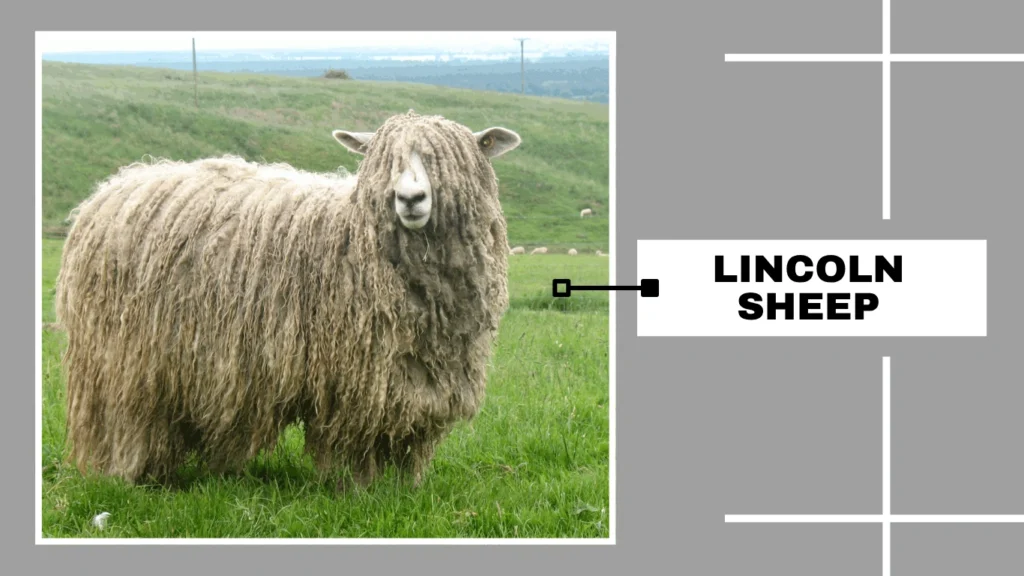
Lincoln Sheep are among the largest and heaviest sheep breeds in the world. Known for producing the longest and heaviest wool of any sheep, they are often used in crossbreeding to improve fleece quality and size.
Identification
- Size: Very large and tall
- Color: White body with a broad, wool-covered face
- Wool: Long, lustrous, and heavy fleece with strong, coarse fibers
- Face: Wooly with a distinctive topknot
- Horns: Polled
- Weight: Rams: 250–350 pounds, Ewes: 200–250 pounds
Natural Habitat and Distribution
Lincolns were developed in Lincolnshire, England, and are now raised in the U.S., Canada, Australia, and the UK. They do well in temperate climates and are best suited to lowland pastures and open grazing systems.
Wool Production and Qualities
Lincoln fleece can grow up to 12–15 inches long annually and weigh over 12 pounds per shearing. The wool is prized for its sheen and durability, commonly used in outerwear, rugs, and felting.
Behavior and Characteristics
Lincoln Sheep are docile, strong, and easy to manage. They do well in structured flock settings and are often used in fiber arts and wool festivals. Due to their impressive size and wool production, they are a favorite among breeders looking for both visual impact and utility.
14. Black Welsh Mountain Sheep

The Black Welsh Mountain Sheep is a small, hardy breed native to Wales. Known for its striking all-black appearance and fine fleece, it’s popular among smallholders and wool enthusiasts.
Identification
- Size: Small and compact
- Color: Entirely black, including face and legs
- Wool: Soft, dense black fleece
- Face: Clean and narrow with a sharp profile
- Horns: Rams are horned with spiraled horns; ewes are polled
- Weight: Rams: 130–160 pounds, Ewes: 100–120 pounds
Natural Habitat and Distribution
This breed thrives in rugged hills and mountainous terrain. It is primarily found in the UK, particularly Wales, and has also gained popularity in North America due to its resilience and visual appeal.
Wool Production and Qualities
The fleece is prized for its natural black color, eliminating the need for dyeing. It is ideal for handspinners and is used in knitting, weaving, and felting. The wool is of medium quality with a strong, springy texture.
Behavior and Characteristics
Black Welsh Mountain Sheep are alert, agile, and excellent foragers. They are independent and perform well in low-input systems. Despite their small size, they are tough and well-suited to harsh environments and steep pastures.
15. Awassi Sheep

The Awassi Sheep is a hardy, fat-tailed breed native to the Middle East. It’s one of the most important dairy sheep in the region, also valued for its meat and wool. Awassi Sheep are well-adapted to hot, dry climates and long migrations.
Identification
- Size: Medium to large
- Color: White body with a reddish-brown face and legs
- Wool: Coarse fleece, uneven in texture
- Face: Broad with drooping ears
- Tail: Large, fat-storing tail typical of desert breeds
- Horns: Rams may be horned; ewes are usually polled
- Weight: Rams: 200–250 pounds, Ewes: 120–180 pounds
Natural Habitat and Distribution
Awassi Sheep are common across Iraq, Syria, Jordan, Israel, and surrounding regions. They are exceptionally suited to desert and arid environments, capable of walking long distances in search of pasture.
Wool, Milk, and Meat Production
Awassi Sheep produce rich, high-fat milk, used in cheeses like feta and halloumi. Their meat is flavorful, and their wool, though coarse, is useful for carpets and outerwear. They are a true triple-purpose breed.
Behavior and Characteristics
Awassi Sheep are intelligent, strong, and sociable. They adapt well to nomadic and semi-intensive systems. Their calm temperament, combined with high milk yield and durability, makes them one of the most economically valuable sheep breeds in dry climates.
16. East Friesian Sheep
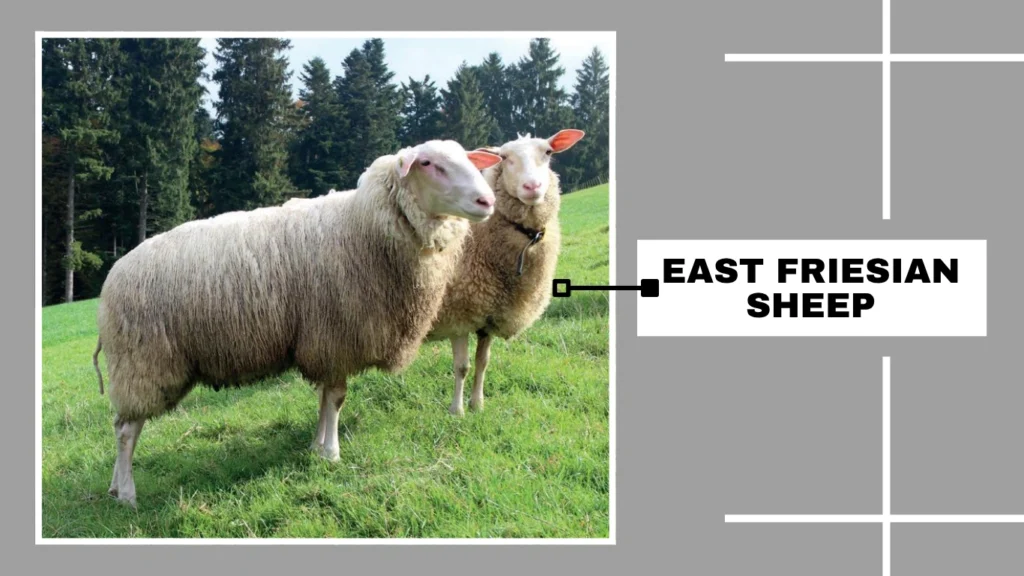
East Friesian Sheep are widely regarded as the highest-producing dairy sheep breed in the world. Originating in northern Germany and the Netherlands, they are prized for their exceptional milk yield and are frequently used in commercial sheep dairies.
Identification
- Size: Medium to large
- Color: White body with a clean pink face and legs; a black or brown face variant exists
- Wool: Medium-fine fleece; less dense due to focus on dairy traits
- Face: Bare and long with a slightly convex nose
- Tail: Naturally thin and should not be docked
- Horns: Polled
- Weight: Rams: 200–275 pounds, Ewes: 150–200 pounds
Natural Habitat and Distribution
East Friesians do best in cool, moist climates with high-quality pasture. Originally from northern Europe, they are now found in North America, New Zealand, and other countries focused on sheep milk production.
Milk Production and Qualities
This breed can produce up to 1,500 pounds of milk per lactation. Their milk is high in fat and protein, ideal for cheese-making. They are often crossbred with hardier sheep to improve milk yield in less forgiving climates.
Behavior and Characteristics
East Friesians are friendly, social, and responsive but require excellent nutrition and management. They are less rugged than other breeds and thrive best in well-maintained pastures with shelter and parasite control.
17. Navajo-Churro Sheep

The Navajo-Churro is the oldest breed of domesticated sheep in the U.S., introduced by Spanish settlers in the 16th century and later adopted by the Navajo people. It is known for its cultural significance, long wool, and resilience.
Identification
- Size: Small to medium
- Color: Highly variable—white, black, brown, gray, or spotted
- Wool: Long, coarse, dual-coated fleece
- Face: Narrow and angular with alert eyes
- Horns: Rams and ewes can have up to four horns; polled individuals also occur
- Weight: Rams: 125–200 pounds, Ewes: 85–120 pounds
Natural Habitat and Distribution
Navajo-Churro Sheep thrive in arid, rugged environments and are commonly found in the southwestern United States, especially in tribal lands and conservation herds.
Wool Production and Qualities
Their wool is ideal for weaving traditional textiles and rugs. The outer coat is long and coarse, while the inner coat is softer. It is favored by fiber artists for durability and natural color variety.
Behavior and Characteristics
These sheep are extremely hardy, parasite-resistant, and low-maintenance. They are excellent foragers and thrive on poor-quality forage. Navajo-Churros are independent, intelligent, and deeply rooted in Navajo culture, where they continue to support traditional arts and self-sufficiency.
18. Icelandic Sheep

Icelandic Sheep are a hardy, ancient breed brought to Iceland by Viking settlers over 1,000 years ago. Known for their versatility, they provide meat, milk, and wool, and are especially prized for their unique dual-coated fleece.
Identification
- Size: Small to medium
- Color: Wide variety including white, black, gray, brown, and spotted
- Wool: Dual-coated fleece (tog and thel); long outer layer and soft undercoat
- Face: Clean with alert eyes and short ears
- Horns: Both sexes may be horned or polled
- Weight: Rams: 175–220 pounds, Ewes: 130–160 pounds
Natural Habitat and Distribution
These sheep are bred to survive Iceland’s harsh climate and sparse forage. They are also raised in North America and parts of Europe, particularly by homesteaders and fiber farmers.
Wool Production and Qualities
Icelandic wool is sought after by handspinners and fiber artists. The outer coat (tog) is strong and water-resistant, while the undercoat (thel) is fine and soft. It’s excellent for garments, felting, and blankets.
Behavior and Characteristics
Icelandic Sheep are bold, independent, and excellent foragers. They are seasonal breeders, easy lambers, and efficient on pasture. Their adaptability and triple-purpose value make them ideal for self-sufficient and cold-climate farms.
19. Border Leicester Sheep
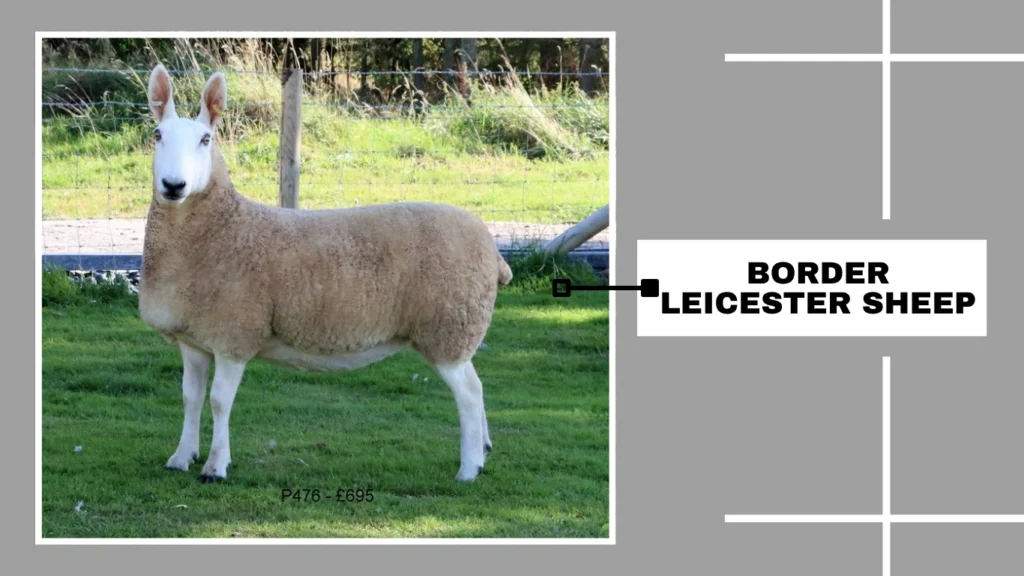
Border Leicester Sheep are a British longwool breed developed in the 18th century. Recognized for their distinctive Roman noses and upright ears, they are primarily used for wool and meat production.
Identification
- Size: Large frame and long body
- Color: White fleece with a clean, white face and legs
- Wool: Long-stapled, lustrous fleece
- Face: Bare, wedge-shaped with an arched nose and upright ears
- Horns: Polled
- Weight: Rams: 225–300 pounds, Ewes: 170–240 pounds
Natural Habitat and Distribution
Originating in the UK, Border Leicesters are now common in Australia, New Zealand, and North America. They thrive in temperate zones with good grazing conditions.
Wool Production and Qualities
Their fleece is long, shiny, and strong, ideal for worsted yarns. It’s often used in weaving and heavy garments. The wool is easy to spin and favored in handcraft markets.
Behavior and Characteristics
These sheep are intelligent, docile, and good mothers. They are popular for crossing with other breeds to improve lamb size and fleece quality. Their strong frames and impressive wool growth make them valuable for both commercial and artisan production.
20. Bluefaced Leicester Sheep

The Bluefaced Leicester (BFL) is a stylish, longwool sheep breed from northern England, named for its distinctive bluish skin visible beneath fine white hair on the face. It is a favorite in both fiber production and crossbreeding programs.
Identification
- Size: Medium to large
- Color: White fleece with a bluish-white face and clean legs
- Wool: Lustrous, fine, long-stapled wool
- Face: Roman-nosed with fine hair; no wool on face or legs
- Horns: Polled
- Weight: Rams: 220–280 pounds, Ewes: 150–200 pounds
Natural Habitat and Distribution
Bluefaced Leicesters do best in mild, grassy regions. They are widely raised in the UK and have growing popularity in the U.S., Canada, and New Zealand, especially among fiber enthusiasts and small-scale producers.
Wool Production and Qualities
BFL wool is soft, shiny, and strong with a long staple, making it ideal for handspinning, lace knitting, and weaving. It blends well with other fibers and takes dye beautifully, making it one of the most sought-after specialty wools.
Behavior and Characteristics
They are calm, alert, and excellent for crossbreeding—often used as sires in creating productive commercial ewes like the “Mule” ewe in the UK. Their fertility, long wool, and friendly temperament make them a solid choice for both wool and flock improvement.
21. Shetland Sheep

Shetland Sheep are a primitive, heritage breed from the Shetland Islands of Scotland. Known for their small size and luxurious wool, they are one of the most colorful and genetically diverse sheep breeds in the world.
Identification
- Size: Small and lightweight
- Color: Wide range including white, black, gray, brown, and multicolored patterns
- Wool: Fine, soft, and crimpy fleece; ideal for delicate textiles
- Face: Small and clean with fine features
- Horns: Rams may be horned; ewes are usually polled
- Weight: Rams: 90–125 pounds, Ewes: 75–100 pounds
Natural Habitat and Distribution
Shetlands are adapted to rugged island conditions with poor forage and cold, wet weather. Today, they are also raised in North America, the UK mainland, and Europe by fiber farms and conservation breeders.
Wool Production and Qualities
Shetland wool is soft and fine, ideal for lightweight garments, lace, and knitting. Each sheep may have a slightly different fiber texture and color, adding to the breed’s appeal for handcrafters.
Behavior and Characteristics
Shetlands are independent, intelligent, and hardy. They are easy lambers and excellent foragers, requiring minimal input. Their manageable size and wide fleece variety make them a favorite among homesteaders, hobby farmers, and fiber artisans.
22. Wiltshire Horn Sheep

Wiltshire Horn Sheep are an ancient British breed known for their self-shedding coat and natural hardiness. Once nearly extinct, they’ve regained popularity due to their low-maintenance nature and excellent meat qualities.
Identification
- Size: Medium to large
- Color: White body with bare face and legs
- Wool: Hair-type coat that sheds naturally in spring
- Face: Clean and narrow with a strong profile
- Horns: Both rams and ewes are horned; rams have large spiral horns
- Weight: Rams: 200–250 pounds, Ewes: 140–180 pounds
Natural Habitat and Distribution
Wiltshire Horns thrive in lowland and upland areas with temperate climates. They are raised throughout the UK, Australia, and increasingly in North America by farmers seeking low-input sheep breeds.
Wool and Meat Production
Though not valued for wool, their meat is high-quality—lean, tender, and flavorful. Their natural shedding eliminates the need for shearing, crutching, or chemical wool treatments, reducing overall labor.
Behavior and Characteristics
Wiltshire Horn Sheep are alert, thrifty, and excellent mothers. They adapt well to pasture-based systems and are often used in crossbreeding to produce hardy, low-maintenance lambs. Their independence and resilience make them ideal for extensive or organic operations.
23. Scottish Blackface Sheep

Scottish Blackface Sheep are one of the most iconic hill breeds in the UK, known for their rugged nature, distinctive appearance, and ability to thrive in extreme weather and mountainous terrain.
Identification
- Size: Medium
- Color: White fleece with a black face; some may have white markings
- Wool: Long, coarse, and durable fleece
- Face: Prominent black face with wide-set eyes and curled horns (in rams)
- Horns: Rams are horned; ewes may be horned or polled
- Weight: Rams: 175–220 pounds, Ewes: 120–160 pounds
Natural Habitat and Distribution
Scottish Blackface Sheep are common in the highlands and uplands of Scotland, Ireland, and northern England. They are built for cold, wet, and rocky environments with poor-quality forage.
Wool and Meat Production
Their wool is coarse and best suited for carpets, mattresses, and tweed. Though the wool has limited textile use, the breed is highly valued for producing strong, flavorful lamb and hardy crossbred ewes (like the Scotch Mule).
Behavior and Characteristics
These sheep are tough, independent, and exceptional foragers. They can survive in areas where other breeds would fail. Their strong maternal instincts and ability to lamb unassisted in harsh conditions make them a cornerstone of hill farming systems.
24. Zwartbles Sheep

Zwartbles Sheep are a striking and friendly breed originally from the Friesland region of the Netherlands. Once used primarily for dairy, they are now valued for their meat, wool, and docile temperament, making them popular with smallholders and hobby farms.
Identification
- Size: Medium to large
- Color: Dark brown to black wool with a distinctive white blaze on the face, white socks, and a white tail tip
- Wool: Dense, soft fleece with medium fiber; no wool on face or legs
- Face: Long and narrow with a white blaze
- Horns: Polled
- Weight: Rams: 200–275 pounds, Ewes: 150–200 pounds
Natural Habitat and Distribution
Zwartbles adapt well to temperate climates with lush pastures. Originally from the Netherlands, they are now found in the UK, Ireland, and parts of North America, favored by farmers seeking calm, productive sheep.
Wool and Meat Production
Their wool is springy, soft, and easy to spin, making it ideal for handcrafts and blended yarns. Meat from Zwartbles is tender, lean, and flavorful, with a mild taste and good carcass yield.
Behavior and Characteristics
Zwartbles are calm, easy to handle, and excellent mothers. Their striking appearance, combined with a gentle nature and dual-purpose productivity, make them ideal for beginner shepherds and small farms.
25. Karakul Sheep

Karakul Sheep are one of the oldest domesticated sheep breeds, originating from Central Asia. They are best known for their lustrous, curly pelts used in traditional garments, and their ability to thrive in desert and semi-arid conditions.
Identification
- Size: Medium
- Color: Typically black at birth, turning brown, gray, or white with age
- Wool: Coarse and long-stapled, with fat-storing tails
- Face: Narrow with long ears and Roman nose
- Horns: Rams may be horned; ewes are usually polled
- Weight: Rams: 175–225 pounds, Ewes: 100–150 pounds
Natural Habitat and Distribution
Karakuls thrive in dry, harsh climates with sparse vegetation. They are raised in Central Asia (Uzbekistan, Turkmenistan), the Middle East, southern Africa, and some parts of the U.S. where hardy breeds are essential.
Wool and Pelt Production
Karakul lambs are known for their luxurious pelts (Astrakhan), often harvested within a few days of birth. Adults produce long, coarse wool suitable for rugs, felting, and durable textiles.
Behavior and Characteristics
These sheep are extremely hardy, able to walk long distances and survive on minimal forage. They are independent, heat-tolerant, and long-lived. Their unique wool and cultural history make them valuable in specialized farming and artisan fiber markets.

